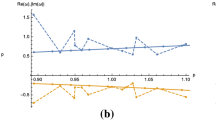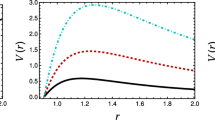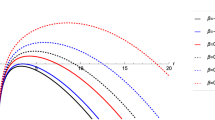Abstract
It is shown that the scalar wave equation in the near-horizon limit respects a hidden SL(2, R) invariance in the Reissner–Nordström (RN) black hole spacetimes. We use the SL(2, R) symmetry to determine algebraically the purely imaginary quasinormal frequencies of the RN black hole. We confirm that these are exactly quasinormal modes of scalar perturbation around the near-horizon region of a near-extremal black hole.

Similar content being viewed by others
References
A. Castro, A. Maloney, A. Strominger, Phys. Rev. D 82, 024008 (2010). arXiv:1004.0996 [hep-th]
C. Krishnan, J. High Energy Phys. 1007, 039 (2010). arXiv:1004.3537 [hep-th]
M. Cvetic, F. Larsen, Nucl. Phys. B 506, 107 (1997). hep-th/9706071
M. Cvetic, F. Larsen, J. High Energy Phys. 1202, 122 (2012). arXiv:1106.3341 [hep-th]
B. Chen, J. Long, Phys. Rev. D 82, 126013 (2010). arXiv:1009.1010 [hep-th]
I. Sachs, S.N. Solodukhin, J. High Energy Phys. 0808, 003 (2008). arXiv:0806.1788 [hep-th]
Y.S. Myung, Y.W. Kim, T. Moon, Y.J. Park, Phys. Rev. D 84, 024044 (2011). arXiv:1105.4205 [hep-th]
Y.S. Myung, Y.-W. Kim, Y.-J. Park, Phys. Rev. D 85, 084007 (2012). arXiv:1201.3964 [hep-th]
S. Bertini, S.L. Cacciatori, D. Klemm, Phys. Rev. D 85, 064018 (2012). arXiv:1106.0999 [hep-th]
C.-M. Chen, J.-R. Sun, J. High Energy Phys. 1008, 034 (2010). arXiv:1004.3963 [hep-th]
T. Ortin, C.S. Shahbazi, Phys. Lett. B 716, 231 (2012). arXiv:1204.5910 [hep-th]
M. Cvetic, F. Larsen, J. High Energy Phys. 1209, 076 (2012). arXiv:1112.4846 [hep-th]
H. Li, arXiv:1108.0220 [hep-th]
C.-M. Chen, S.P. Kim, I.-C. Lin, J.-R. Sun, M.-F. Wu, Phys. Rev. D 85, 124041 (2012). arXiv:1202.3224 [hep-th]
S. Ferrara, G.W. Gibbons, R. Kallosh, Nucl. Phys. B 500, 75 (1997). hep-th/9702103
R.G. Daghigh, G. Kunstatter, D. Ostapchuk, V. Bagnulo, Class. Quantum Gravity 23, 5101 (2006). gr-qc/0604073
W.T. Kim, J.J. Oh, Phys. Lett. B 514, 155 (2001). hep-th/0105112
S. Hod, Phys. Lett. A 374, 2901 (2010). arXiv:1006.4439 [gr-qc]
Y.S. Myung, T. Moon, Phys. Rev. D 86, 024006 (2012). arXiv:1204.2116 [hep-th]
V. Cardoso, J.P.S. Lemos, Phys. Rev. D 63, 124015 (2001). gr-qc/0101052
R. Cordero, A. Lopez-Ortega, I. Vega-Acevedo, Gen. Relativ. Gravit. 44, 917 (2012). arXiv:1201.3605 [gr-qc]
E. Berti, V. Cardoso, A.O. Starinets, Class. Quantum Gravity 26, 163001 (2009). arXiv:0905.2975 [gr-qc]
Acknowledgements
We would like to thank B. Chen and C.-M. Chen for helpful discussions. This work was supported by the National Research Foundation of Korea (NRF) grant funded by the Korea government (MEST) through the Center for Quantum Spacetime (CQUeST) of Sogang University with grant number 2005-0049409. Y.S. Myung was also supported by the National Research Foundation of Korea (NRF) grant funded by the Korea government (MEST) (No. 2012-R1A1A2A10040499). Y.-J. Park was also supported by World Class University program funded by the Ministry of Education, Science and Technology through the National Research Foundation of Korea (No. R31-20002).
Author information
Authors and Affiliations
Corresponding author
Appendix: A computation of QNFs around the near-extremal RN black hole
Appendix: A computation of QNFs around the near-extremal RN black hole
In this appendix, we show that a scalar propagating around the near-horizon region of a near-extremal RN black hole has purely imaginary QNFs. Let us start with the Schrödinger equation (59) with the near-horizon and near-extremal RN potential (62). Introducing a new variable [20]
Eq. (59) can be written as

By changing to a new wave function y through
Eq. (A.2) can be transformed into a standard hypergeometric equation [21]
with

In order to obtain the quasinormal modes, we have to check whether or not solutions of Eq. (A.2) satisfy the boundary conditions: ingoing waves near the horizon (x=0) and zero (Dirichlet condition) at infinity of x=1. Taking into account e −iωt, such a solution takes the form of
where 2 F 1[a,b,c;x] is a standard hypergeometric function. Imposing the boundary condition at infinity (x→1, ρ ∗→0, \(\tilde{\rho}\rightarrow\nobreak \infty\)), we recall a property of the hypergeometric function
The Dirichlet boundary condition can be achieved when choosing
with n=0, 1, 2,… . Therefore, using (A.8) together with (A.5), the QNFs are given by
which are combined to give a single expression of purely imaginary QNFs
This is the exactly same form as found in the QNFs (66).
Rights and permissions
About this article
Cite this article
Kim, YW., Myung, Y.S. & Park, YJ. Quasinormal modes and hidden conformal symmetry in the Reissner–Nordström black hole. Eur. Phys. J. C 73, 2440 (2013). https://doi.org/10.1140/epjc/s10052-013-2440-8
Received:
Published:
DOI: https://doi.org/10.1140/epjc/s10052-013-2440-8




